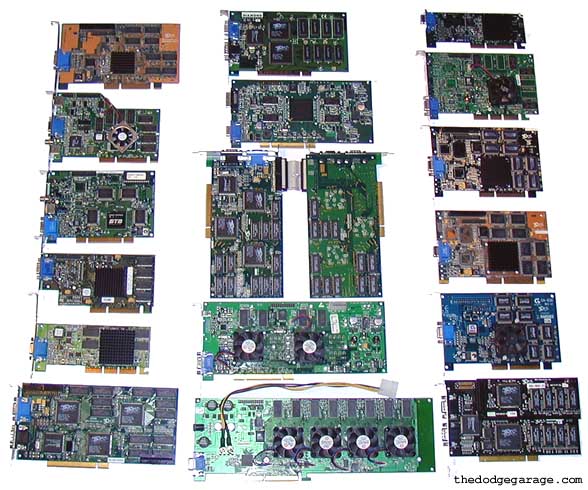

21 card benchmark shootout


The Cards Tested-
Diamond Monster 4 MB (50 mhz)
Quantum3D Obsidian SB50-4440 (50 mhz)
Quantum3D Obsidian 100SB-4400V (50 mhz)
Pre-Production Voodoo 2 8MB (90 mhz)
Pre-Production Voodoo 2 12 MB SLI (90 mhz)
Pre-Production AGP Banshee (100/100mhz)
Gigabyte AGP Banshee (110/128mhz)
Prototype Voodoo 3 (143 mhz)
Prototype Voodoo 3 MCM (143 mhz)
Pre-Production Voodoo 3 (164 mhz)
Compaq V3-3500 non-TV (183 mhz)
Prototype Daytona 32 MB DDR (143 mhz)
V5-4500 (166 mhz)
V5-5500 AGP (166 mhz)
V5-6000 AGP (167 mhz)
All Voodoo cards used the last available driver from 3dfx.
Intel i740 8MB (Last intel
reference driver used)
STB Velocity (RIVA) 128 PCI 4MB (Last Nvidia reference driver used)
ATI Dell Rage 128 Ultra 32 MB (Dell Rage Ultra driver used)
Canopus TNT 16 MB (Last Canopus driver used, unable to use reference driver)
G-Force 2 MX 32 MB (Nvidia 4.14.10.5664 reference driver used) 175/175 mhz
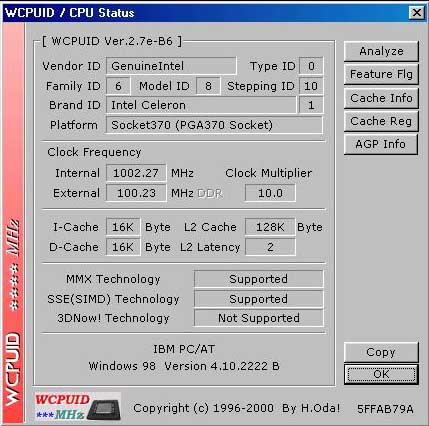
Platform- Celeron Coppermine 1000 mhz (10 x 100), Abit BH6 with Intel BX chipset, 196 MB ram, dual Maxtor drives & Win98SE. More CPU power then most of these cards ever saw in their lifetime but would eliminate the CPU as the bottleneck on the lower end. It must also be noted some cards scale better then others with increasing CPU power, this will be to their advantage.
Turok- Just the demo, fire it up and benchmark mode and let it run.
GLquake- If comparing numbers, my version has pak files redone for clear water.
Quake II- With point release.
Quake 3- Clean install with last point release.
In all cases except where noted games were runs "as installed" no tweaks were made to enhance or degrade performance for any of the video boards. Runs were made twice, sometimes more if there was a discrepancy.
I would say that the card that has the largest advantage is the G-Force 2 MX as it has the benefit of a transformation and lighting engine, current refined drivers and Open GL is Nvidia's playground.
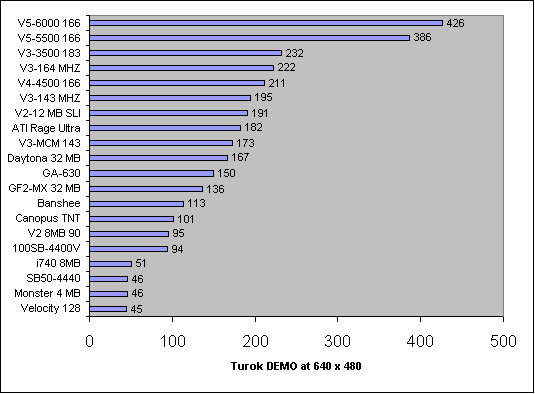
Turok (640 x 480) doesn't seem to take advantage of the second TMU of the SB50 leading me to think that it is a single pass, non-multi-texturing rendering engine. This is confirmed by comparing the single TMU Banshee cards to the dual TMU Voodoo 2 8 MB. By virtue of their high clock speeds they walk away from the V2 card. Even the single TMU Voodoo Graphics SLI board is giving the dual TMU V2 card a run for the money! Lets see how things look when we introduce an engine that takes advantage of multiple TMU's.
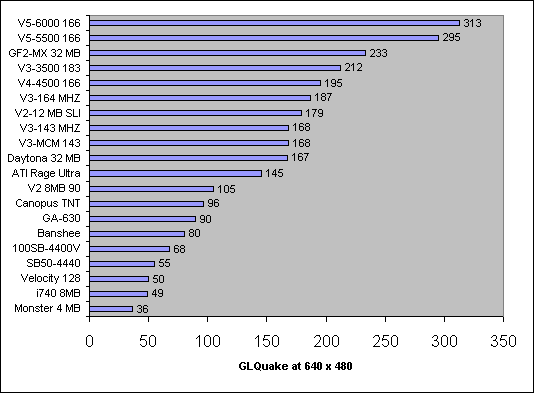
We see a different picture here- The cards with dual texture management units clearly pull away from their single texture unit counterparts! The spread on the two Voodoo Graphics is amazing considering they have the same clock speed. Also of note is the two 12 MB Voodoo 2's in SLI mode- They maybe only poking along at 90 mhz but they are showing the 143 mhz Voodoo 3 and Daytona cards how two cards in parallel can get the job done. You notice the same trend farther up the chart as the V3-164 mhz and 4500 166mhz huddle together and then you see the dual VSA-100 5500 just pulling away flexing it's dual processors. The 6000 is doing well but I suspect it is begging for a faster CPU to feed it data based on how close the 5500 is running. It does do well here as this game has fairly simple CPU demands though. We see this trend get worse as the games get more complex.
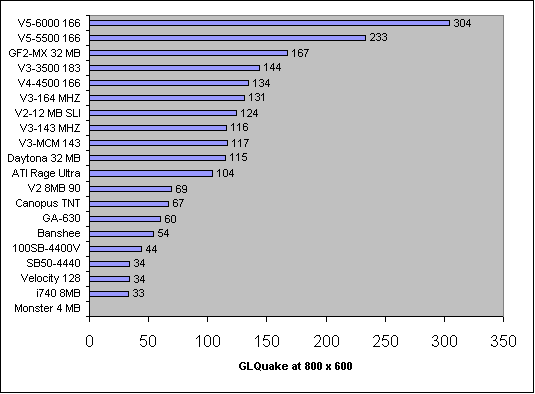
The Voodoo Monster board can't run at this screen resolution with z-buffer enabled, it doesn't have enough ram. Please take note of the Nvidia TNT position in the chart- Nvidia made a big deal about the TNT chip being a "Voodoo SLI killer" in Quake and we can plainly see it being beaten by a single 8 MB Voodoo 2! The SLI rig just decimates the TNT and the Canopus card was the cream of the TNT crop back in the day.
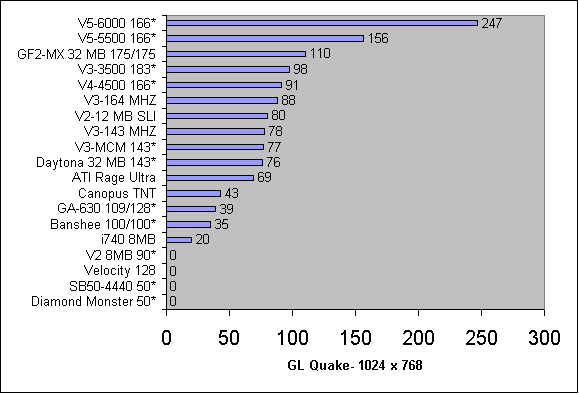
At 1024 x 768 a few more boards drop out due to ram limitations and the SLI rig is still hanging tough but look at the V5-6000! It just blows the rest of the field away in an awesome display of raw power. With the CPU only being used "lightly" by the Quake engine the card can run at top speed.
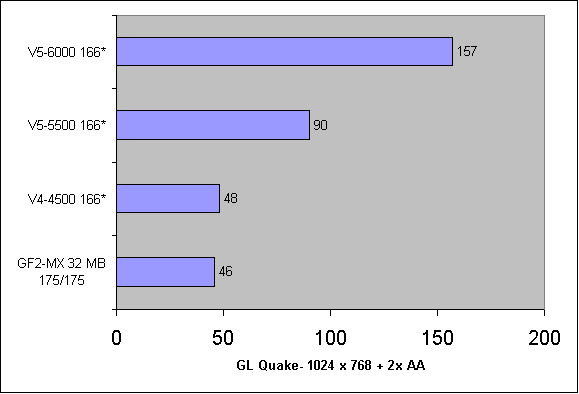
Now for something different- At 1024 x 768 we turn on 2 x anti-aliasing and see how they stack up. Interesting that the slower clocked V4-4500 pulls away from the Geforce 2 MX. Once again the 6000 displays it's massive memory bandwidth and squashes the other cards like bugs.
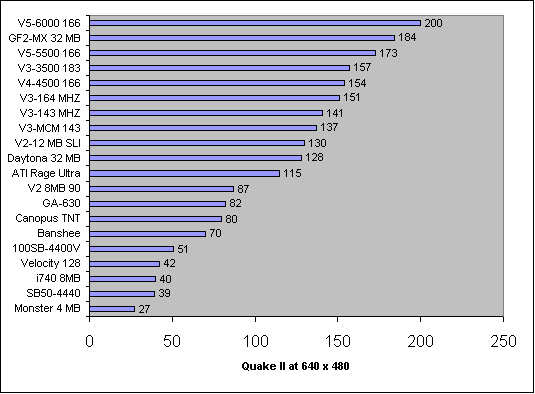
On the Quake II engine we note something interesting happen- As the geometry & lighting calculations get more complex we see less CPU power available for feeding the V5-6000. The G-Force card is clearly nipping at the 6000's heels at this resolution.
The Nvidia card has the triple advantage of current drivers, built in hardware transformation and lighting engine (which the 3dfx cards don't have) and a complex game engine sapping precious CPU power. Since the 3dfx cards depend on the CPU for the geometry and lighting calculations and the G-Force doesn't... Advantage Nvidia.
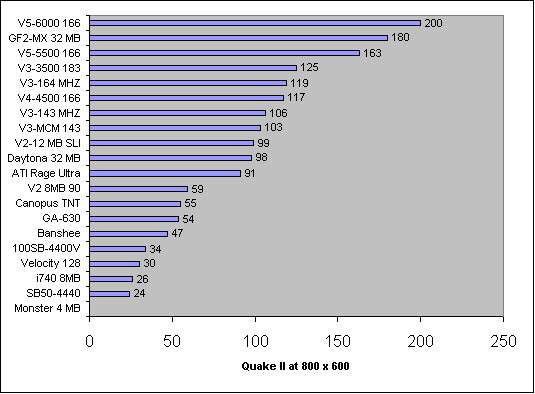
With no real change in standing among the upper cards clearly the CPU is still playing the staring role at 800 x 600.
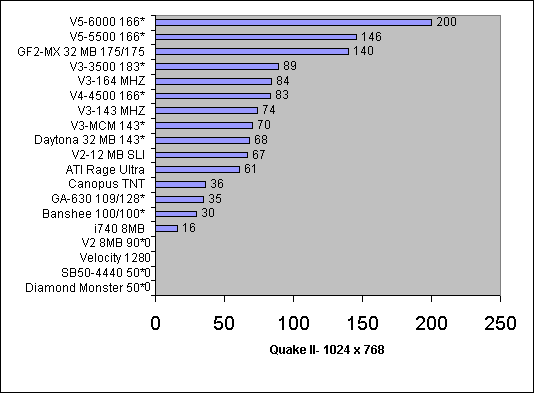
Note the 6000 hasn't even budged off the 200 fps mark, clearly it is hardly working and waiting for data from the CPU. It will be interesting to retest the 6000 on a more powerful platform in the future.
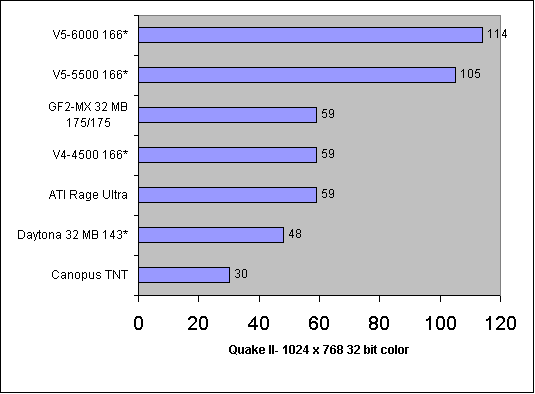
Cranking on the 32 bit color increases the load on the memory pipeline... and the multi-chip configurations of the 5500 and 6000 start to shine. While 3dfx pursued parallel processors with their own ram as a way around memory bottlenecks, Nvida and other board makers resorted to faster and more expensive ram. Pity I didn't have a DDR G-Force to run tests on and compare results.
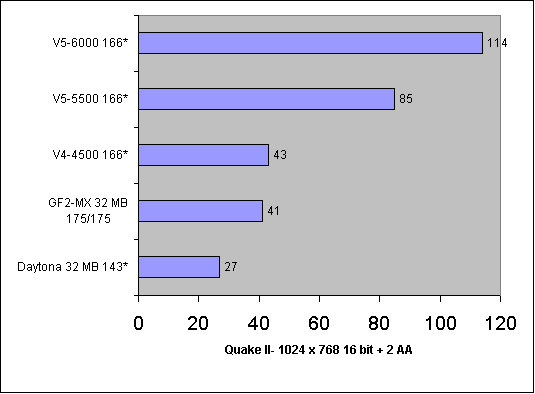
In this test we turn on the anti-aliasing and observe the results- Once again the multi processor cards show off their multi path memory strategy.
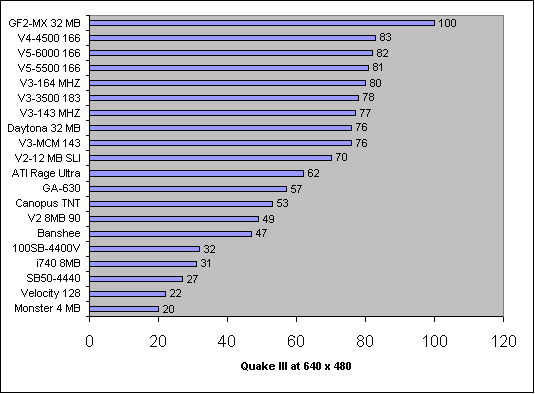
Amazing, the 4 MB Monster card is still hanging in there! A different pattern starts to emerge with the Quake 3 engine. Clearly the 1000 mhz Celeron isn't feeding the Quake 3 game data to the 3dfx video cards fast enough and we see them all topping out around 80 fps. The Tn'L engine of the Nvidia card is really shining in the complex Quake 3 environment! What is also surprising is that the GA-630 Banshee single TMU card edging out the single dual TMU Voodoo 2 8 MB. I suspect the GA-630's clock speed and unified 16 MB of ram is giving it an advantage in this polygon filled environment over the Voodoo 2's 8 MB which has to be split three ways. Notice the 4500 taking the top 3dfx honors? I suspect the single VSA-100 chip card has more aggressive ram timings due to it's non multi-chip configuration.
Lets see what happens when we crank up the screen resolution and make the cards work harder.
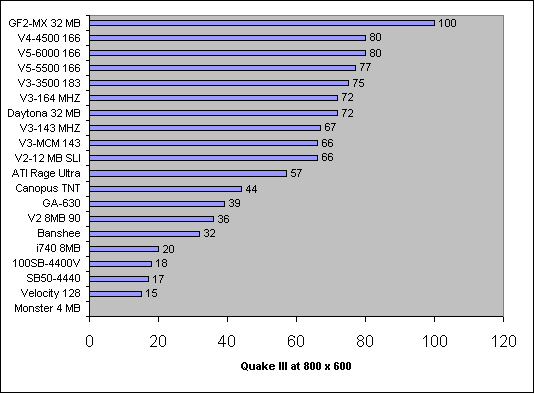
The same story repeats itself at 800 x 600 with the weaker cards struggling to maintain over 30 fps. The Quantum3D Voodoo Graphics cards are still hanging tough but nothing to write home about.
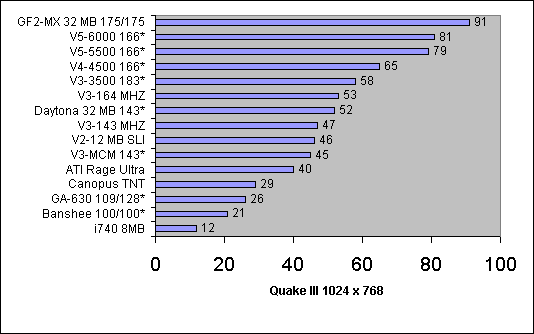
As the resolution climbs to 1024 x 768 we start to see a shake out on the various cards. The Banshee's extra ram isn't enough to offset the missing TMU and slower ram speeds at this resolution and the SLI V2 rig is still flexing it's muscles. We see the V3-MCM card drop to the bottom of the Voodoo 3 group, I suspect it has very conservative memory timings based on all the benchmarks and it's starting to show. The Daytona has a nice lead over the similar clocked V3 cards, not sure if it's due a more efficient chip or something to do with the DDR ram timings. The GF2 is still taking full advantage of the situation as the 5500/6000 cards starve for data. Time to turn up the heat with 32 bit color and see what flies loose.
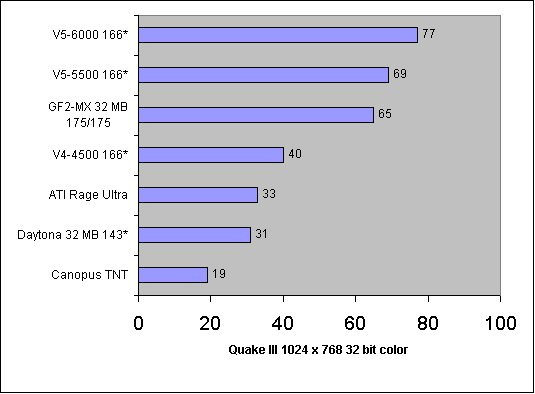
The 5500 & 6000 surge ahead as 32 bit color comes on-line and increases the memory bandwidth demand. Note the 6000 has maintained around 80 fps even though we have bumped up 3 resolutions and added 32 bit color! Clearly the card is being starved for data.
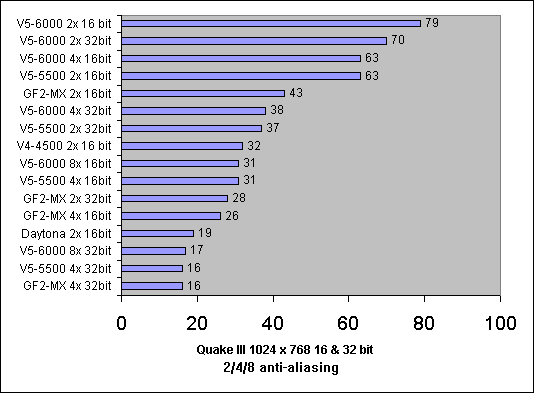
The big one- 1024 x 768, 16 and 32 bit color, 2, 4 and 8 x anti-aliasing. The 6000 takes the top three honors.
Thanks for visiting this page and take from it what you will. This page was done to show the general performance differences between the various 3dfx cards with a few other cards thrown in for the heck of it. Most of my prototype cards work and I'm not one to place them in a shrine and never use them, it was fun to run them through their paces.
General notes on the cards and a few screen shots. Sorry about the lack of shots on some of the voodoo cards, I really didn't start to take them till the end of testing.
Diamond Monster- Typical Voodoo Graphics card used as a baseline, I'm the original owner! Card has served me well over the years and spent some time in a few relatives computers as well before returning home.
Quantum3D Obsidian SB50-4440- Voodoo Graphics with 4 MB each for the FBI and 2 TMU's for a total of 12 MB of ram. A cranking card back in the day, expensive too. Think 50 mhz Voodoo 2 and you have the right idea.
Quantum3D Obsidian 100SB-4400V- Single PCB Voodoo Graphics SLI board and 2d daughter card with 12 +2 MB of ram. One of the fastest Voodoo Graphics available back in the day, fast as a Voodoo II in some games! Runs 800 x 600 with ease as well.
Pre-Production Voodoo 2 8MB- A pre-production board, chances are it was sent out as part of a developer kit to a vendor like Diamond, Orchid, etc..
Pre-Production Voodoo 2 12 MB SLI- A set of pre-production boards, chances are it was sent out as part of a developer kit to a vendor like Diamond, Orchid, etc. Interesting to note one of the boards has 110 mhz ram.
Pre-Production AGP Banshee- Early board, development kit perhaps.
Gigabyte AGP Banshee- One of the fastest Banshees, thrown in as a reference. You can click here to see the GA-630 display properties in a new window.
Prototype Voodoo 3 143 mhz- Very early alpha board that I had the good luck to find and the better luck to find someone who could repair it!
Prototype Voodoo 3 MCM- Engineering sample, one of 8 or 12 made! Very conservative ram timings.
Pre-Production Voodoo 3 164 mhz- Not sure what to think of this one, chances are developer board or "press" card.
Compaq V3-3500 NON-TV 183 mhz- One of the rarest production Voodoo 3 cards made, a 3500 series with no tuner assembly available only on certain Compaq PC's.
Prototype Daytona 32 MB DDR 143 mhz- Engineering sample, Daytona card number two. The Daytona was built on a .18 micron die process for low power consumption and uses inexpensive 64 bit DDR ram. It really runs no faster then a similar clocked V3 or VSA-100 with 128 bit SDRAM. You can click here to see the Daytona display properties in a new window.
V5-4500 166 mhz- Typical 4500 card with one thing to note. When I first started doing the benchmarks I was running a 5500 in single chip mode to simulate a 4500. When I happened to install a 4500 in the test computer I noted that the benchmarks were slightly faster! I'm fairly sure that the 4500 has more aggressive ram timings since it doesn't have to sync to another processor.
V5-5500 AGP 166 mhz- Typical V5-5500 AGP card, thrown in as a yardstick.
V5-6000 AGP 167 mhz- The big dog, V5-6000 3700 A with 128 MB of ram. Card has been converted over to internal power connector and has full internal PCI rework. Anti-aliasing in all modes (2/4/8) available and the card is dead stable and not for sale. You can click here to see the V5-6000 display properties in a new window.
Intel i740 8MB- Nice little card, good reference drivers from Intel, stable and has great image quality. I had one of these in my rig back in the day working with a pair of Voodoo 2 cards.
STB Velocity (RIVA) 128 PCI 4MB- Card has the worst image quality imaginable. In Quake 3 there was missing textures in some areas and the game just looked like ass. It maybe a little faster then one or two of cards in the lineup but my advice is to avoid it like the sloppy 'ho it is.
ATI Dell Rage 128 Ultra 32 MB- Found it in a pile at my buddies computer store, I'm pleasantly surprised. Good image quality and the card doesn't seem to loose a terrible amount of performance going to 32 bit color in some applications. No driver control panel options with the proper Dell driver though.
Canopus TNT 16 MB- Decent image quality, had to use the last available Canopus 2500 driver since the latest Detonator drivers can't identify the card!
G-Force 2 MX 32 MB- Good Winfast card used for a number of years. Early drivers were a little buggy but later ones seem solid. The GF2-MX has 45% more fill rate then the original GF-SDR, AnandTech has a great article on the GF2-MX card here.